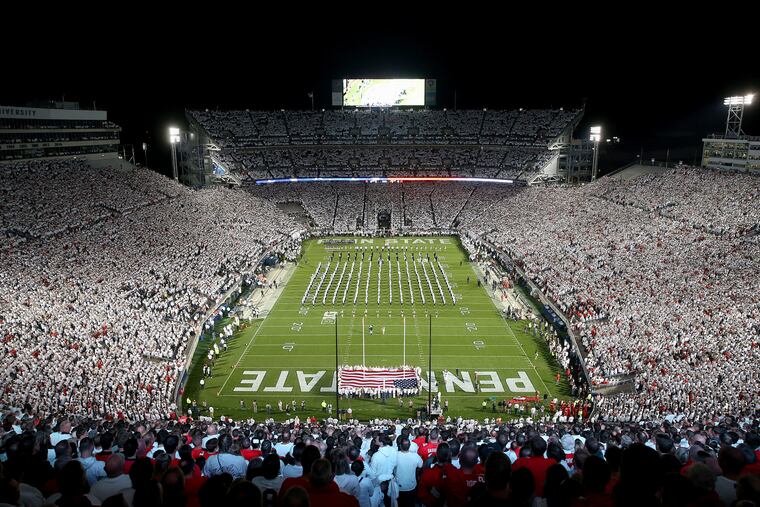Paying student-athletes fundamentally changes college sports — and maybe not for the best | Opinion
New legislation won't do anything to level the playing field, writes Temple University sports business professor.

On Monday, California Gov. Gavin Newsom signed a bill that will allow college student-athletes in the state to receive compensation for the use of their name, likeness, or image, and to hire agents to represent them. This will change college athletics as we know it today — and it might not be for the best.
Many student-athletes approve of the law, but the NCAA, the body that regulates university-level athletic programs, is aggressively opposed to it. Many of the universities directly affected by the legislation also have come out against it, including Pac-12 members USC and Stanford.
The bill states that collegiate student-athletes may receive compensation for, in effect, striking endorsement deals with organizations. The compensation will be negotiated by agents on behalf of the student-athlete. Neither the university nor the athletic department will be part of the transaction.
The new law is in direct conflict with NCAA regulations that state that student-athletes can receive compensation only related to education. For example, through athletic department scholarships, student-athletes have the ability to receive tuition, room and board, and books. Any student-athlete who accepts compensation beyond education will be declared ineligible at that school. California’s law is clearly in conflict with NCAA rules. Yet following the California measure, lawmakers in several other states, including Pennsylvania, announced plans to create similar legislation.
This law is intended to get the NCAA to change its rules regarding compensation for student-athletes, but in my view, it doesn’t fully consider the consequences. Those include:
Unfair competitive balance: For example, in Division I college football, there are approximately 20 teams that historically stay in the top 25 rankings annually. Most of football’s top 10 ranked teams play on national television each weekend, which means they will have more exposure and become more valuable to sponsors. A recruit will want to go to these schools as they will have a better opportunity to garner more sponsorship dollars. It will just increase the grip these top teams have on winning.
Scheduling limitations through NCAA or conference mandates: If the issue’s not settled in the courtroom, the NCAA could prohibit member teams from playing teams in states that allow compensation to student-athletes. This would severely reduce the schedule for the athletic teams that abide by additional student-athlete compensation, limiting their exposure both for home games and ratings on television. This could feasibly force these universities to confront their lawmakers to amend the bill.
Gender inequality: This is not a Title IX issue as the compensation is not coming from universities themselves, but it will widen the gap between financial and other support for men’s compared with women’s sports. Football and men’s basketball players will have better opportunity to earn more than a vast majority of other sports, no matter male or female. Again, this is because most of the football teams and men’s basketball earn higher ratings on television, driving more value for a player, as he will be seen by many people, driving his popularity.
Television broadcast rights agreements: Deals between broadcasters and the major collegiate conferences are all coming up for renewal in the next few years. This could cause conference realignment or a flat-out break from the NCAA if there is not some type of agreement between the NCAA and states. University athletic departments are part of conferences, which negotiate broadcast agreements on behalf of its members. Broadcast rights go beyond television as streaming games on multiple platforms is becoming more and more common. Teams are mostly part of a conference because of the additional revenue that can be brokered through broadcast agreements. If teams in a conference have schedule limits by NCAA rules due to Fair Pay to Play compensation, this could force realignment.
Eligibility guidelines: There are two different distinctions for the student-athlete under the NCAA law now: how to stay eligible at the school, and how to stay within the NCAA. And the requirements might not align. It would appear that under California guidelines, an athlete can form an agreement with a consumption platform like YouTube to have their own show and be compensated. In the past, the agreements were with the conference or the university.
Sports agency sponsorship: How about if a sports agency is the actual sponsor of a student-athlete so they can benefit later when that athlete could potentially sign a huge professional contract?
It appears the law in California states student-athletes’ sponsorships can’t compete with its athletic department’s sponsorships, but what if it ends up being cheaper to go directly to a student-athlete instead of the athletic department and get similar impressions? Essentially a student-athlete would be competing with its own athletic department for sponsorship money. Sponsorship money to athletic departments helps pay for expenses, including facility upgrades.
I am for student-athletes getting what they deserve for bringing a valuable proposition that generates revenue. That applies from a Heisman Trophy winner to an equestrian student-athlete. However, this is not just a simple solution to compensate student-athletes — it has potential for unintended consequences and will fundamentally change college athletics.
John Allgood is academic director of the Executive Master Science in Sport Business and assistant professor at Temple University’s School of Sports, Tourism, and Hospitality Management. Allgood worked in the sports industry for 20 years.